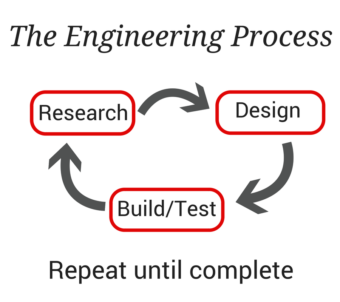NGSS Ideas
When Engineering Happens: How Mini Skateboards Teach Design Thinking
“We tried all the systems that had been tried before, then we tried our own systems and we tried some combinations that no one had ever thought of. Eventually, we flew.” – Orville Wright
When you think about STEM (Science, Technology, Engineering, and Math-related programs), the “science” and “math” parts of the acronym are the ones we can relate to. Those were two of the mandatory subjects we all studied starting as young children on through high school. 
Technology speaks to today’s students, who use it to support and enhance learning. Woven into the fabric of what kids learn is the impact that technology has on our everyday life. And we adults can easily appreciate how and why it would factor into education.
But engineering?
Most people think of engineering as something you learn in college or even grad school. They see it as something that requires at least a high school education. It is hard for most of us to grasp that our children can understand the basic principles from an early age. Engineering is a set of practices and tools that integrate inquiry and design to solve a problem. This is something that can be applied at any age. In fact, children are natural engineers.
I prefer examples to help me understand, so here’s an example of the Engineering Process that took place in my house:
Take, for example, my twelve-year-old son. He loves anything having to do with skateboards, snowboards or scooters. If he’s not out on one of them, then he likes to play with the miniature versions created by Tech Deck.
Recently I marveled from the sidelines as he aced engineering principles in his quest to build a custom, rounded quarter pipe for his Tech Deck equipment. Here is the process he went through:
First, he appropriated a four-inch piece of floor trim that had come loose from one of our walls and glued it to an existing Tech Deck jump. I appreciated his ingenuity, but I told him he couldn’t use a piece of our wall – even if it had come loose and neither of his parents had made an effort to glue it back in place. But I digress…
Next, we found another piece of wood that could potentially work, but when my son realized he’d have to cut it with an electric saw of some kind, which meant setting up the equipment and cleaning up a mess, he decided against it.

He switched to cardboard.
His next move was to determine the dimensions of his jump and cut some cardboard pieces to be used for the support. He cut these using a Penblade precision cutting tool (one of my favorite tools) and some good scissors. He then glued them together using E6000 Craft adhesive. 
After the E6000 set for awhile, he realized it was more flexible then he wanted and the jump would wobble. To solidify the joints, he used Elmer’s Glue All. Once the glue dried, he adhered the jump surface to the base using packing tape to ensure a smooth ride. He also added a CAPiTA sticker, which I think made it a little edgy. The end product was a solid jump, ready for action.
But what’s a jump without the ride? My son then built a snowboard by cutting out the shape from several pieces of card stock, gluing them together, then shaping them as they dried.
of card stock, gluing them together, then shaping them as they dried.
The result was a firm but flexible board that works nicely on his do-it-yourself quarter pipe as well as on the purchased jumps he owns.
ICYMI, here’s how my son demonstrated the engineering process with this project:
1. He identified an enhancement to his Tech Deck collection: A new quarter pipe jump.
2. In thinking about how to create it, he went through a first iteration design in which he glued a spare piece of wood to an existing jump. This failed.
3. He reconsidered his material source but stuck with his original design. Realizing that he’d need a power tool to cut the wood caused this second try to fail as well, but he still had a design.
4. He then changed the materials and created the jump. This time the glue failed, but he had a workable framework.
5. Adding a second kind of glue, plus packing tape, allowed him to complete his design implementation.
So the next time your child decides to do a project where they are building something from scratch, be sure to be encouraging. After all, today’s Tech Deck tinkerer may just be behind tomorrow’s engineering marvel.
